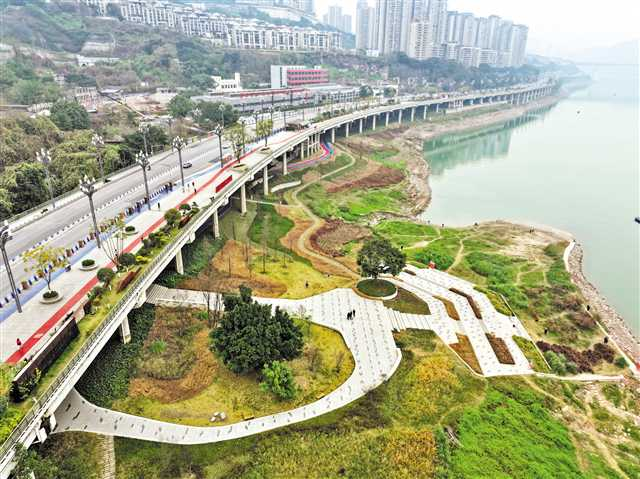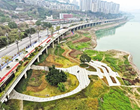Chongqing News
Tips for exploring Hongyancun Bridge
2024-02-18 11:55:30

CHONGQING (CQNEWS) -- Connecting Hongyancun (Hongyan Village) in Yuzhong District and Dashiba in Jiangbei District, Hongyancun Bridge has become a great magnet for visitors with its unique square archways known as the Gates of Chongqing and the Eyes of Chongqing.
Where is the best place to shoot the Gate of Chongqing? Mr. Liu, a Beijing tourist who has been to Chongqing times, suggested visiting Tingfeng Jiangtan on Beibin Road.
“Boasting fabulous scenery, Tingfeng Jiangtan is located at the Yangpao Bureau section of Beibin Road. Whether you are in search of a leisurely stroll or exciting cycling, or looking to photography, it provides the perfect backdrop,” said Mr. Liu.
The Yangpao Bureau section of Beibin Road has been open to public since the New Year’s Day this year. The place got its name because it is adjacent to the Military Industry Theme Cultural and Creative Park in Chongqing. The Yangpao Bureau 1862 Cultural and Creative Park Project aims to build a lively cultural and creative block where the ancient industrial workshops and factories retain their original flavor and tell the story of the historical evolution of Shanghai Yangpao Bureau, China's earliest factory making armaments in modern times.
We visited 1862 Wharf (Zhongshutuo Wharf) to see if the scenery at the Yangpao Bureau section lived up to its reputation.
As you descend from 1862 Wharf, you will see an eye-catching Ficus viren standing tall on the riverside and the yellowish fountain grass in deep contrast with the dark green river. Despite the cold weather, the wind blows gently across the river here, and many visitors come to seek a relaxing and peaceful moment.
1862 Wharf offers spectacular views of the Jiahua Bridge and the super high-rise building Land-sea International Center as well as the brightly colored Hongyancun Bridge, where you will be amazed by the marvelous bridges and city landscape in Chongqing.
Going up 1862 Wharf will find you at the main road of the Yangpao Bureau section, a red and blue riverside walkway. A walk of a few hundred meters along the walkway will lead you to Tingfeng Jiangtan Viewing Platform, one of the best attractions at the Hongyancun Bridge with breathtaking views of the piers of the Hongyancun Bridge.
As Tingfeng Jiangtan is well placed for easy photography, it has become a popular place for photo taking on Beibin Road, said Jiangbei Urban Construction Company.
As you progress along the riverside walkway, you will see the recently completed Baren Jishui Park, another attraction at the Yangpao Bureau section reproducing the scenes in ‘Baren Jishui (Ba people draw water)’. ‘Baren Jishui’, produced in 1938, is representative of Xu Beihong’s work of the period, presenting the Chongqing people’s spirit of resistance.
A small waterfall on the hillside constitutes one of the most stunning scenery in Baren Jishui Park. Different from common waterfalls, it is divided into four or five streams by the uneven surface of the hill, blending well with the lively scene around it. There is a small pool of water below the waterfall, adorned with the beautiful red plum blossom and azaleas.
Going down the steps of Baren Jishui Park will bring you to Xu Beihong Art Museum. Located in Shijia Park, Dashiba Sub-district, Jiangbei District, Xu Beihong Art Museum is a garden-style building combining Chinese and Western artistic features and offering works of calligraphy, stone carving, and architectural art. The 100-year-old museum was formerly the private residence of Shi Rongting, a famous wealthy businessman in Chongqing. The art museum is home to works of great masters and contemporary young Chongqing artists.
The Beibin Road Yangbao Bureau Governance and Upgrading Project covers from Jinyuan Road to Shuibin Road, with a total length of 5.2 kilometers, said Jiangbei Housing and Urban-rural Development Commission. The project focuses on ecological conservation and restoration and aims to build a dynamic cultural and creative riverside space by making use of military cultural resources. The project includes the greening of the wharf and retaining walls, the improvement of intertidal zones, the reconstruction of spaces under bridges, the building of walkways, and the development of characteristic culture.
Upon completion, the Yangbao Bureau section will run into the areas around the estuary of the Panxi River, and connect the riverside walkway under the Gaojia Huayuan Bridge with the walkways below the Shimen Bridge and the Jiahua Bridge, making Beibin Road more attractive and offering more riverside spaces for leisure and entertainment.
Tips for exploring the Yangbao Bureau section of Beibin Road >>>
Self-drive route: Drive to Nushutuo Wharf.
Public Transport: Take Line 5 to Dashiba Station, and then walk from Exit 3A to 1862 Wharf → Tingfeng Jiangtan Viewing Platform → Baren Jishui Park → Xu Beihong Art Museum. (Translated by Yuki, Fathom Language Limited)
Editor:Jiang Yiwei

 手机阅读分享话题
手机阅读分享话题